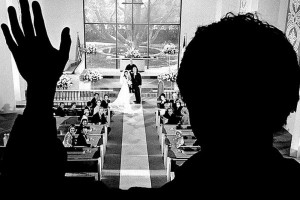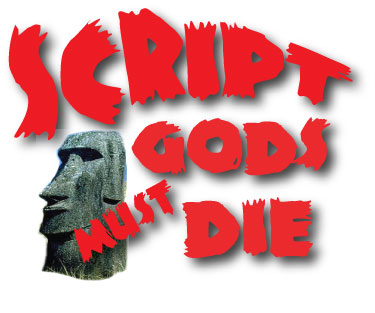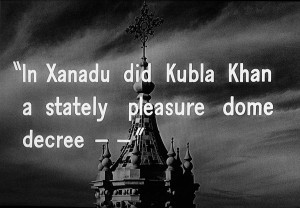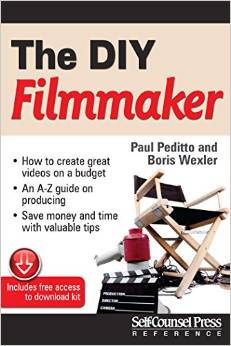Point Of Entry is a tricky one. Robert McKee, one of the original Script Gods, in his book Story, wrote about inclusion and exclusion. One of the most important skills a screenwriter will ever need is knowing what stays, and what goes.
So where do you start your script? Any rules that can help guide you?
Couple things. Events should be interconnected, not random. It’s not A happens, then B happens, then C happens. More likely, it’s A happens, therefore B happens, which in turn causes C to occur. Causality. We want the Point Of Entry to set off the chain of events that will become the movie.
I look for four things to be established in the first pages:
- The world
- The tone
- The key characters
- Beginnings of conflict
Let’s examine some pro scripts with excellent points of entry. I’m Southern Italian, so you know I’m going to The Godfather first….
A HIGH ANGLE of the CORLEONE MALL in bright daylight. There
are at least five hundred guests filling the main courtyard
and gardens. There is music and laughing and dancing and
countless tables covered with food and wine.
DON CORLEONE stands at the Gate, flanked on either side by a
son: FREDO and SONNY, all dressed in the formal attire of
the wedding party. He warmly shakes the hands, squeezes the
hands of the friends and guests, pinches the cheeks of the
children, and makes them all welcome. They in turn carry
with them gallons of homemade wine, cartons of freshly baked
bread and pastries, and enormous trays of Italian delicacies.
The entire family poses for a family portrait: DON CORLEONE,
MAMA, SONNY, his wife, SANDRA, and their children, TOM HAGEN
and his wife, THERESA, and their BABY; CONSTANZIA, the
bride, and her bridegroom, CARLO RIZZI. As they move into
the pose, THE DON seems preoccupied.
DON CORLEONE
Where’s Michael?
SONNY
He’ll be here Pop, it’s still early.
DON CORLEONE
Then the picture will wait for him.
Elegant sequence centering on Connie’s wedding. We set up the tone (drama), the world (40’s/period-piece), the key characters(above) and beginnings of conflict. Recall, the Sinatra character wanting the movie part, sets up the second sequence (Los Angeles) which sets up the classic horse’s head in the satin sheets scene. Sequence 1 leads naturally to Sequence 2. You just knew Frankie would get that part….
 An equally famous point of entry happens in The Graduate. Tell me this doesn’t set the table of the world and tone, plus place you right in poor Benjamin’s mind. It also thematically states what the movie will be about in no uncertain terms:
An equally famous point of entry happens in The Graduate. Tell me this doesn’t set the table of the world and tone, plus place you right in poor Benjamin’s mind. It also thematically states what the movie will be about in no uncertain terms:
28 INT. BEN’S ROOM – NIGHT – CLOSEUP – BEN
His eyes are open and he is trying to remember something.
There are the SOUNDS of many people TALKING and LAUGHING
in other rooms. A RADIO nearby PLAYS MUSIC. After a
while, there is the SOUND of a DOOR OPENING. The SOUNDS
of the people TALKING are lower. MRS. TERHUNE’S voice
can be heard among them.
MRS. TERHUNE’S VOICE
— associate editor of the college
newspaper in his junior year –
managing editor in his senior
year –
The SOUND of the DOOR CLOSING. Mrs. Terhune’s VOICE and
the VOICES of the other guests FADE DOWN.
After a few moments, there is the SOUND of a LIGHT SWITCH
being SNAPPED and light, as though from an overhead fixture,
falls across BEN’s face. He does not move.
MR. BRADDOCK’S VOICE
What’s the matter?
Ben’s mouth opens a little bit and closes again.
MR. BRADDOCK’S VOICE
The guests are all downstairs,
Ben. They’re all waiting to see you.
BEN
Look, Dad – could you explain to
them that I have to be alone for
a while?
MR. BRADDOCK’S VOICE
These are all our good friends,
Ben. Most of them have known you
since – well – practically since
you were born.
Ben has not moved. Now the bed on which he is lying moves
as though someone has sat down upon it next to him.
MR. BRADDOCK’S VOICE
What is it, Ben?
BEN
I’m just –
MR. BRADDOCK
– worried?
BEN
Well –
MR. BRADDOCK
About what?
Ben
I guess – about my future.
MR. BRADDOCK
What about it?
BEN
I don’t know. I want it to be –
MR. BRADDOCK
To be what?
BEN
(quietly)
Different.
Causality. Guess who Ben meets and drives home from the party? Yep, Mrs. Robinson. Once back to her place the seed is planted (“Mrs. Robinson, you’re trying to seduce me.”) Which is then acted upon, which leads to complications when Ben dates Elaine, which leads to….get the idea? Connectivity, causality…without the party, there is no movie. This is what you need to consider when picking a scene to open your screenplay.
I’ll have to leave the non-classic movies for another time. Can’t really leave this conversation without talking Citizen Kane, and R O S E B U D. Here’s the opening after the Kubla Khan intro:
In the glass panes of the window, we see reflected the ripe, dreary landscape of Mr. Kane’s estate behind and the dawn sky.
INT. KANE’S BEDROOM – FAINT DAWN – 1940
A very long shot of Kane’s enormous bed, silhouetted against the enormous window.
INT. KANE’S BEDROOM – FAINT DAWN – 1940
A snow scene. An incredible one. Big, impossible flakes of snow, a too picturesque farmhouse and a snow man. The jingling of sleigh bells in the musical score now makes an ironic reference to Indian Temple bells – the music freezes-
KANE’S OLD OLD VOICE
Rosebud…
The camera pulls back, showing the whole scene to be contained in one of those glass balls which are sold in novelty stores all over the world. A hand – Kane’s hand, which has been holding the ball, relaxes. The ball falls out of his hand and bounds down two carpeted steps leading to the bed, the camera following. The ball falls off the last step onto the marble floor where it breaks, the fragments glittering in the first rays of the morning sun. This ray cuts an angular pattern across the floor, suddenly crossed with a thousand bars of light as the blinds are pulled across the window.
The foot of Kane’s bed. The camera very close. Outlined against the shuttered window, we can see a form – the form of a nurse, as she pulls the sheet up over his head. The camera follows this action up the length of the bed and arrives at the face after the sheet has covered it.
FADE OUT.
There’s no movie without this point of entry. As opposed to our first two examples, this is non-linear structure. That means, on the movie clock, we’re at about 11:30 at night. Yes, the death of Kane in real time drives the search for the meaning of the word Rosebud. But in movie time, we come very close to full circle, beginning with almost the end of the movie. All that remains–SPOILERS–is for that sled to be shoved into the fire. Oh, how about that, Rosebud was a sled!
This opening sets up everything–the tone, world, key character, and conflict. There is causality…if Kane doesn’t die, there’s no movie. This is #1 on the AFI All-Time 100 movies for a reason. Kane’s point of entry is inviolate and inevitable.
There is nowhere else the movie could have started.
Find that place in your movie, you’ll be off to a good start.




